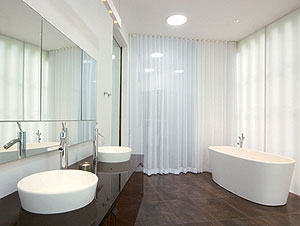Bethesda, Maryland
Shinberg.Levinas
Painting pictures with words would seem to be a lawyer’s strength. But when a single father of two contacted Bethesda, Maryland–based Shinberg Levinas two and a half years ago requesting a master suite for his house nearby, partners Salo Levinas, AIA, and Antonio Vintro were given no hint that this suburban spread was dismal. “It needed so much work,” Levinas recalls, upon seeing the 2,500-square-foot, 1950s-era home. “I said it’s better to leave the house alone.”

Architect
Shinberg.Levinas
General contractor
Residential Resource
Structural engineer
Shemro Engineering
Lighting design
Gaspar Glusberg
Sources
Hansgrohe Axor (fittings); Wet Style (sinks, tub); Hill Enterprises (cabinets); Porcelanosa USA (tile); Sistemalux (lighting)
Instead, Shinberg Levinas designed a 600-square-foot addition that connects to the original by a delicate bridge and provides the owner with an architecturally and acoustically distinct, cocoonlike space. The new pavilion is composed of a pair of nested volumes: A “shell,” characterized by an elbow curve, contains the bathroom and walk-in closet; it wraps around two sides of a near rectilinear bedroom. This second shell, clad in vertical planks of Brazilian ipé wood, protects the bedroom from street noise.
Experiencing the pavilion from within, it becomes apparent that the curved volume directs all views and thoughts to the woodsy landscape. Toward the rear of the house, the shell volume splays outward. Moreover, its ipé skin gives way to an expanse of glass, punctuated by only a small column of horizontal slats that overlooks the backyard. This reverse-tapering gesture combines with the glazing to “explode to the outside,” Levinas says. “We go from the narrow closet area, and then open and open to really try to engage the outdoors.” To ensure the view is unobstructed, the architects placed a toilet cubicle just inside the walk-in closet.
The landscape then becomes a kind of interior ornament. The only opening in the ipé skin is a large, milky-white window, under which the architects installed a lozenge-shaped resin tub. This increases diffuse daylight in the room while maintaining privacy from a nearby neighbor, and also transforms the window into a wallpaper on which vertical exterior slats and trees cast a dance of shadows.
Interior finishes do not compete with the scenery. The shower wall is made of the same white glass as the tub window; other walls are covered in a textured fiberglass-threaded fabric painted white, 18-by-24-inch tiles appear like plates of steel while sheer white curtains soften the building’s edges, and the curves of the fixtures reference the the architecture. The results are quiet, contemplative, and perfect for one—although Shinberg Levinas cunningly included an extra sink for a potential girlfriend.

Post a comment to this article
Report Abusive Comment